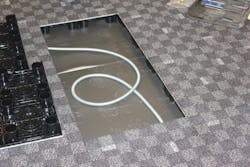PowerFlor streamlines cable management for security control rooms
One of the biggest challenges for any contemporary security control room or video surveillance monitoring center is how to manage the myriad of cables that must be integrated into the facility. In an existing building, installers usually have to rip up the ceilings, floors and walls to run power and data cords, leading to costly renovation work.
However, a flooring solution dubbed the "PowerFlor" aims to streamline this cable management quandary. PowerFlor enables users to route their cabling through a raised floor with removable tiles. Not only does this eliminate the need to tear up walls and ceilings, but it also provides a way to quickly change cabling infrastructure by simply reconfiguring a few flooring tiles.
"The product addresses the issue of cabling installation regardless of the purpose of the cabling or what the connectivity requirement are," said Ed Franz, president of PowerFlor. "The fact is that most of the connectivity in today’s world, whether it is security, power, data or whatever it is, it has been relegated to various building voids and those voids are inaccessible, unadjustable and very inadaptable in most cases. We’ve tried to reverse that thinking process with our approach so we give an additional building void in an almost non-building fashion that provides a space for cabling."
Franz added that the raised floor concept, which has been around since the late 1960s, is prevalent in Europe where he estimated that between 60 to 80 percent of commercial buildings used them.
"It’s normal over there," he said. "They recognized a long time ago that running all of our cables in the ceiling really didn’t make much sense."
According to Jim Norton, president of Minn.-based Custom Products & Services, the PowerFlor essentially acts as a "floating floor," enabling installers to locate and change power or data outlets to fit the needs of the application.
"If they decide they want to reconfigure that room, you simply pick up the tile that contains the outlet and put it where you want it and reconfigure it because it’s not attached to the floor," he said. "That’s one of the (benefits) of this system is it is so easy to change and reconfigure the room for how it is going to be used just because nothing is permanent."
In addition to security control rooms, Franz said that the PowerFlor has been deployed by a number of police stations that use video walls to monitor camera feeds.
"These kinds of facilities are often located in the basement or on the first floor where there is a slab-on-grade physical environment and they have a huge quantity of cabling," Franz explained. "There’s nothing less-friendly than a concrete floor or concrete block walls when you are trying to deal with this."
Norton said the value of the PowerFlor really comes into play at facilities where the uses of a room may change over time.
"You have to look carefully at what the usage of the room is going to be," Norton said. "If they are going to use the room the same way for the next 20 years it doesn’t make a difference how you (run cabling), but if that room is going to change or if in five years they are going to remodel, put in new furniture and reconfigure the room, you would like to have a system where you don’t have bring in three different trades to do so."
About the Author
Joel Griffin
Editor-in-Chief, SecurityInfoWatch.com
Joel Griffin is the Editor-in-Chief of SecurityInfoWatch.com, a business-to-business news website published by Endeavor Business Media that covers all aspects of the physical security industry. Joel has covered the security industry since May 2008 when he first joined the site as assistant editor. Prior to SecurityInfoWatch, Joel worked as a staff reporter for two years at the Newton Citizen, a daily newspaper located in the suburban Atlanta city of Covington, Ga.

